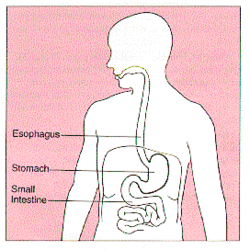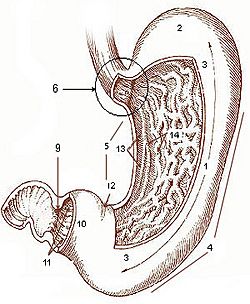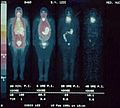Stomach facts for kids
Quick facts for kids Stomach |
|
|---|---|
 |
|
| The stomach is located centre left in the human body. | |
 |
|
| This picture shows different parts of the stomach. | |
| Latin | Ventriculus |
| System | Digestive system |
| Artery | Right gastric artery, left gastric artery, right gastro-omental artery, left gastro-omental artery, short gastric arteries |
| Vein | Right gastric vein, left gastric vein, right gastroepiploic vein, left gastroepiploic vein, short gastric veins |
| Nerve | Celiac ganglia, vagus nerve |
| Lymph | Celiac lymph nodes |
| Precursor | Foregut |
The stomach is a very important organ in your digestive system. It is like a stretchy bag inside your body. It sits between your oesophagus (food pipe) and your small intestines.
When you eat, food travels down your oesophagus and into your stomach. The stomach's main job is to hold the food. It then breaks it down into smaller pieces. This prepares the food for the next part of digestion. After the stomach, food moves into the small intestine. Most of the food's nutrition is absorbed there.
What Does the Stomach Do?
Your stomach has special cells that make hydrochloric acid. This acid is very strong! It helps to kill any bacteria that might be in your food. This keeps you safe and healthy.
The acid also helps special helpers called enzymes to work. These enzymes are like tiny workers. They break down the protein in your food. The stomach also churns and squeezes the food. This mixes it with the acid and enzymes.
After all this mixing and breaking down, the food turns into a thick liquid. This liquid is called chyme. It then moves from your stomach into your small intestine.
Common Stomach Problems
Sometimes, the stomach acid can cause problems. One problem is a peptic ulcer. This is a sore spot in the lining of the stomach. The acid can make these sores worse.
Another common problem is heartburn. This feels like a burning pain in your chest. It happens when stomach acid goes back up into your oesophagus. This is called "reflux." Luckily, these problems can often be treated. Medicines can help by making the acid less strong.
Sometimes, food can come back up from the stomach. This is called vomiting. It happens when food goes up the oesophagus and out of your mouth. Vomiting can be a sign that you are sick.
Animal Stomachs
Did you know that not all stomachs work like human stomachs? For example, some animals like cows are called ruminants. They have a stomach with many different parts.
In these animals, food goes through the first part of their stomach twice! This helps them digest tough foods like grass. Tiny bacteria inside their stomach do a lot of the work.
Other common words for stomach are belly and tummy.
Images for kids
See also
 In Spanish: Estómago para niños
In Spanish: Estómago para niños







